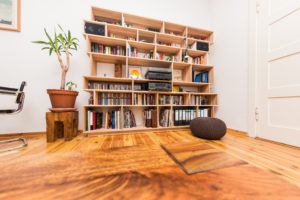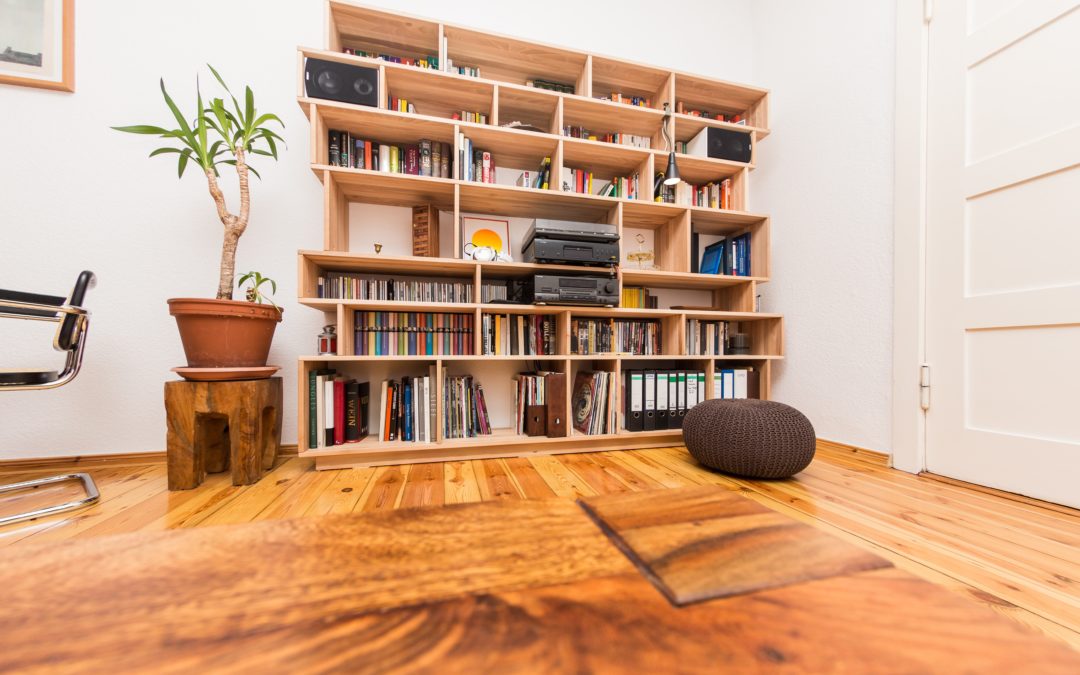A home’s flooring contributes to the physical appearance of the interior and its acoustics, ease of maintenance, and overall feel. Hardwood floors are the premier flooring option for many homebuyers, but this option presents additional choices. Do you want solid wood or engineered hardwood? Clients often ask about the difference between the two. Use this guide to help you understand the qualities of each flooring type.
What Is Solid Wood?

Solid wood refers to a piece of lumber milled and cut from a single piece of wood. The planks are usually narrow. They commonly range from 2.25 to 4 inches, with most planks measuring around 3 inches. However, wide-plank options exist. These flooring options minimize the number of seams in a particular space and better emphasize the visible characteristics of the wood.
For floors, solid wood options are typically from hardwood species, which are more durable and resilient than softwoods. Common species used for home flooring include oak, cherry, walnut, birch, and maple. The flooring characteristics vary depending on the type of wood you choose. Each has distinctive shades and grain patterns and a particular capacity to resist impacts. However, solid wood floors offer extensive life spans due to their natural durability and relative amenability to repeated refinishing.
Solid wood is often available in either an unfinished or a prefinished condition. Finishing is the process of refining and sealing the wood, which improves its appearance and protects its core from factors such as moisture and dirt. Unfinished solid wood planks undergo finishing after installation, while prefinished planks have already undergone sanding, staining, and sealing before reaching the installation site.
What Is Engineered Hardwood?
Engineered hardwood consists of a core of multiple layers of wood adhered together, with hardwood veneers on the top and bottom. The backing material consists of material such as plywood or fiberboard, with usually five to seven layers arranged perpendicularly (in a crisscross fashion). This arrangement helps to maximize the strength and stability of the wood, improving its adaptability to fluctuations in temperature and humidity.
The veneer gives engineered wood the appearance of hardwood. This surface layer can vary in thickness. Often, higher-quality engineered hardwoods feature thicker veneers, while economic options have thinner ones.
Compared to solid wood, engineered hardwood is more commonly available in wider-plank options, with standard widths from 2.25 inches to 7 inches. In terms of thickness, though, engineered hardwood is usually slimmer. Solid wood and engineered hardwood tend to max out at three-quarters of an inch thick, but the latter commonly gets as thin as three-eighths of an inch, compared to the typical half-inch minimum of solid wood. In most cases, these engineered planks are unfinished.
The Pros and Cons of Solid Wood Floors
Solid wood floors have several advantages compared with engineered hardwood floors. One of the primary advantages is the durability of solid wood. This quality mainly results from the ability to refinish the wood multiple times throughout its life span. Refinishing involves sanding down the surface of the wood and applying fresh finishing materials. Since solid wood is a single piece of wood throughout, it can better withstand layer removals, whereas engineered wood has only a veneer of solid wood that’s often risky to sand down more than once or twice.
Also, solid wood is often the better option for matching new installations to existing floors. Say that you already have hardwood flooring in the entry, and you want matching floors in the living room. Even if it proves difficult to find visually similar wood options, the availability of unfinished solid wood means that it’s easy to match colors during the finishing stage.
However, solid wood flooring has a notable downside: its vulnerability to moisture. Whether it’s a leak, a spill, or a humid environment, moisture can cause solid wood to warp and deteriorate. You may want to consider a different flooring option if you have a subsurface of concrete, which is porous and facilitates moisture transfer.
The Pros and Cons of Engineered Hardwood Floors
Engineered hardwood also offers advantages as a flooring option. Its structural arrangement bolsters its stability, making it more resistant to warping. Thus, it’s a more sensible option across various environments and subsurface materials, including concrete.
For another, engineered hardwood is relatively easy to install due to the broader range of installation methods. Whereas solid wood flooring typically involves nailing down the wood to the subsurface, engineered wood allows for alternative techniques such as stapling, gluing, floating, and click-locking. This streamlined installation makes engineered wood a sensible choice for DIY projects, and it helps reduce the overall cost of labor.
However, you should consider some concerns if you’re thinking about going with engineered hardwood. One is the potential susceptibility to impacts. Remember that the core of the wood consists of less-resilient materials like plywood, which can more easily become damaged. That’s why it’s essential to be mindful of choosing high-quality engineered hardwood.
Another potential downside is the life span. Regular refinishing is vital for maintaining your floors, but engineered hardwood is generally less amenable to refinishing than solid wood. As a result, you can expect about 20 to 30 years from engineered hardwood floors. Investing in a product with a thicker, higher-quality veneer may extend this durability.
Solid Wood Versus Engineered Hardwood Prices
The last central point of comparison between solid and engineered hardwood is price. Engineered hardwood tends to be slightly less expensive. The average range of prices is from $3 to $14 per square foot. In contrast, the prices for solid hardwood starts at $8 per square foot and can go up to $15 per square foot, according to flooring estimates from The Spruce.
If you’re interested in hardwood floors, we can help you choose. We include prefinished solid oak or engineered hardwood floors in the entry, nook, kitchen, powder room, bathroom, and dining room, among our standard features. We strive to build you the home you’ve envisioned, based on either our floor plans or a custom house plan that meets your specifications.
If you’d like to meet with one of our housing specialists to discuss your needs, flooring and otherwise, please feel free to send us a message through our contact page. Alternatively, give us a call at 219-255-4453 during operating hours. We’re open seven days a week — Monday through Friday from 9 a.m. to 5 p.m. and weekends from 1 to 5 p.m.
We look forward to working with you to help you realize your dream home.

